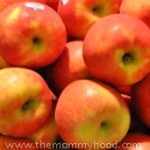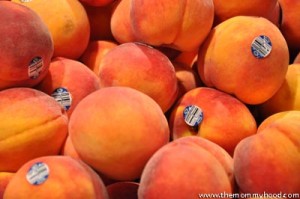 The following is part II of a guest post by the wonderful and talented Cat McAfee of Queen Bee McAfee. Cat is the wife of a master gardener and is sharing tips for selecting the freshest fruits with TheMommyhood.com. This list is a compilation of things she has picked up over time from different sources, and she is interested in any feedback you all have that would improve the tips, so don’t be shy if you have additional tips.
The following is part II of a guest post by the wonderful and talented Cat McAfee of Queen Bee McAfee. Cat is the wife of a master gardener and is sharing tips for selecting the freshest fruits with TheMommyhood.com. This list is a compilation of things she has picked up over time from different sources, and she is interested in any feedback you all have that would improve the tips, so don’t be shy if you have additional tips.
Grapes: Select the bunch that is on the greenest vine/stem. When you get home, separate all of the grapes from the vine. This helps them last longer. Best time to buy: July to December.
Bananas: Separate them into individuals rather than leaving them as a bunch on your countertop. They turn brown more quickly when left as a bunch. If you store them on their backs they bruise more easily. Bananas laying on their side will ripen faster.
Grapefruits and Oranges: Pick the ones that are the smoothest. The more textured peels suggest a thicker rind and an immature fruit. Also, the firmest, heaviest fruits have the most juice (a rule of thumb for nearly every fruit). Color doesn’t really matter. A ripe grapefruit can still be greenish. A ripe orange can be yellowish or even slightly green.
Apples: Look for firm fruit with no bruises or wrinkles. Apples last longer in the crisper of your refrigerator; so stock up when your favorite variety goes on sale.
Pears: Look for firm fruit with no bruises or wrinkles. If they aren’t completely ripe, place them near a citrus fruit on the counter to speed the ripening process.
Cantaloupe: Sniff the blossom end of the fruit (the end opposite the stem) and only select the fruit that has a full, fruity aroma. Also, you want the skin to be yellowish, rather than greenish. Best time to buy: June, July and August.
Watermelon (advice from a watermelon farmer): Go for the ones that are dull in appearance. Shiny means they are not quite ripe. Unlike cantaloupes, you can’t smell a watermelon to help determine ripeness. Instead, look for symmetry in the shape and avoid flat yellow spots, which indicate the melon has spent a fair amount of time being transported while resting on its side. Select a watermelon that seems dense and heavy for its size and produces a pingy hollow sound rather than a dull thud when thumped.
Honeydew: Should smell sweet. Give it a knock on the side and listen for a deep sound – not a hollow, higher sound.
 Peaches and Nectarines: Select a peach or nectarine that is firm with only a slight give at the seams – not rock hard. A ripe fruit will be orangey-red with no green patches.Beware of mushy spots, and void them if they don’t have a strong, peach-y smell. Do not store them in the refrigerator because they will get mushy. To ripen, place them in a brown paper bag. Best time to buy: August and September.
Peaches and Nectarines: Select a peach or nectarine that is firm with only a slight give at the seams – not rock hard. A ripe fruit will be orangey-red with no green patches.Beware of mushy spots, and void them if they don’t have a strong, peach-y smell. Do not store them in the refrigerator because they will get mushy. To ripen, place them in a brown paper bag. Best time to buy: August and September.
Strawberries: Smell them. They should be luscious and red. They do not ripen further once picked, so avoid any green ones. Smaller strawberries have more flavor than bigger ones. And do not wash strawberries until you are ready to eat them.
Tomatoes: The best tomatoes will be a bright red color and give a little (enough to bounce back and not remain indented) when pressed. A tomato that feels slightly heavy for its size indicates it’s dense and juicy and ready to eat. The skin should be smooth and not at all wrinkled or shriveled.
Do you have any tips to add?
 Cat McAfee is really fun and the mother of three gorgeous kids Cole (10), Cooper (5) and Ivy (2). She blogs about her family at Queen Bee McAfee, so be sure to stop by her blog and say hello!
Cat McAfee is really fun and the mother of three gorgeous kids Cole (10), Cooper (5) and Ivy (2). She blogs about her family at Queen Bee McAfee, so be sure to stop by her blog and say hello!









No comments yet.